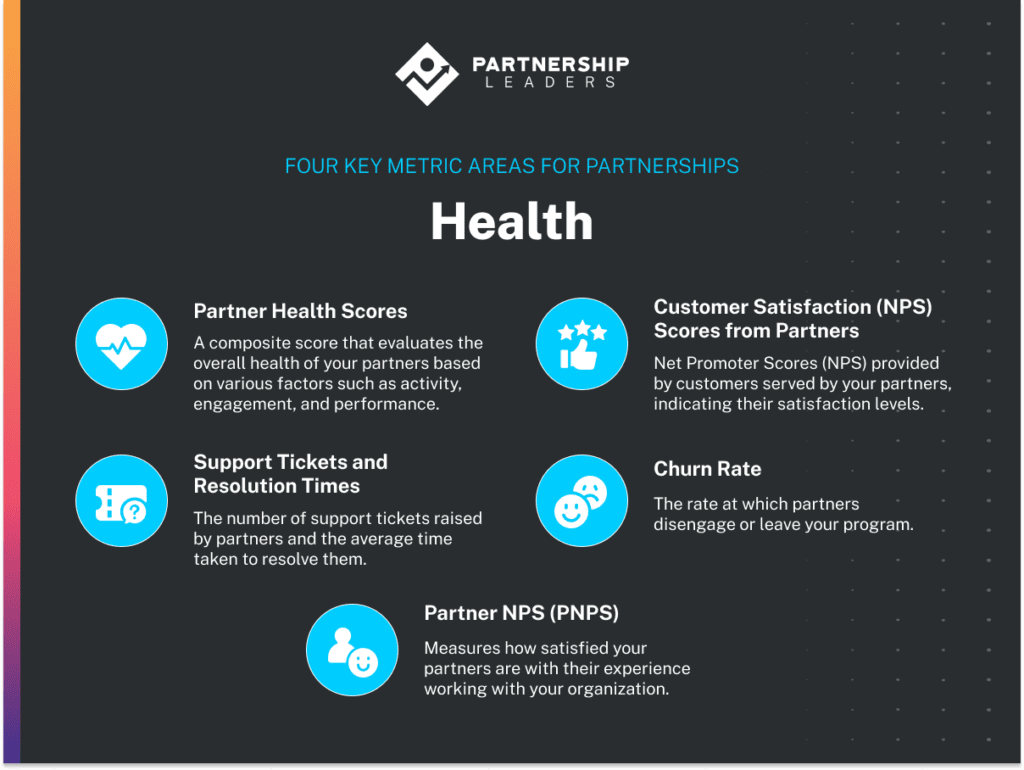Adapted from Greg Portnoy’s session.
Tracking performance and setting clear expectations are crucial to validating your partner ecosystem and program. Without the right metrics, it’s impossible to know what’s working and what needs improvement.
This guide will help you turn your partnership data into actionable insights and communicate them effectively. Featuring insights from Greg Portnoy’s (CEO & Co-Founder, EULER) session on “Success Metrics: Critical KPIs and How to Track Them,” we’ll explore best practices and strategies for a thriving partner ecosystem.
Why You Need to Measure Partnership Success
Here are a few reasons why tracking metrics is crucial:
- Validation: Measuring performance shows that your partnerships drive real value.
- Improvement: You can identify what’s working and what isn’t.
- Resource Allocation: Ensure your team is focused on the right activities.
- Transparency: Provide clear insights to stakeholders and gain internal buy-in. (The number one priority for every partnerships pro!)
As Greg puts it, “Ultimately, revenue is almost always the North Star.” Without these metrics, you’re navigating blind and missing out on opportunities to collaborate with other stakeholders to strengthen your partner ecosystem.
Four Key Metric Areas for Partnerships
So, how do you follow the North Star? By tracking the right metrics, you can steer your partner ecosystem towards success. Revenue, engagement, performance, and health metrics each play a vital role in painting a comprehensive picture of your program’s effectiveness.
Let’s break down these key metrics and see how they can guide your strategy and decision-making.
1. Revenue
Revenue metrics are the lifeblood of any partnership program. They directly show the financial impact of your efforts. This includes a range of metrics that gives a thorough view of how partnerships are contributing to your bottomline, including:

- Partner-Sourced Revenue: Revenue generated directly through partner referrals or sales.
- Influenced Revenue: Revenue where partners played a role in closing the deal, even if they didn’t generate the initial lead.
- Pipeline Value: The total value of deals in the pipeline attributed to partners.
- Revenue Growth Rate: The rate at which revenue from partnerships is growing over time.
Here’s how it works:
Track partner-sourced revenue to help you identify your top performers and allocate more resources to support them. Monitoring influenced revenue now helps you understand the broader impact of your partners on your sales process.
However, some industries, markets, and company sizes may require more nuance when monitoring revenue metrics.
“For the right partners, starting with influenced revenue can then build the flywheel for sourced revenue, if done right,” said Gautham Pandiyan, VP of Partner Ecosystem Growth Acceleration at Qualtrics. “Wins breed wins.”
Pipeline value then shows the potential revenue from partner-sourced and partner-influenced revenue. Then, you can analyze the revenue growth rate to adjust your strategies and sustain or accelerate growth.
2. Engagement
Unlike revenue metrics which focus on financial outcomes, these metrics measure the level of activity and interaction within your partner ecosystem.
Engagement can come in different forms, but here are the most common ones:

- Partner Activation Rate: The percentage of partners who start actively engaging after signing up.
- Number of Touchpoints: How often you interact with your partners, including meetings, emails, and other communications.
- Number of Enablement Sessions: The total number of training and enablement sessions conducted for partners.
- Number of Partner-Personnel Enabled: The number of individuals from partner organizations who have been trained and enabled to effectively work within your ecosystem.
- Partner Logins and Activity: Frequency of logins to your partner portal and engagement with provided resources.
- Certification and Training Completion: How many partners complete your training programs and certifications.
Hex is a great example of increasing partner engagement. They created shared Slack channels for each partner to track “how many people in a partner org are aware of Hex and receiving content updates.”
Ariel Harnik, Head of Partnerships at Hex, and her team also use these channels to track partner usage of Hex products, including:
- How many of their partner’s employees have a Hex login?
- How many projects have they created?
- How many views does a specific project have?
Other good Engagement metrics include deal registrations and leads developed through marketing.
Deal registrations are the number of deals registered by partners. According to Jen Waltz, Founding VP, Global Alternate Channels at Kron Technologies, you can use this metric to assess the effectiveness of your co-sell efforts and joint account mapping.
On the other hand, leads generated through joint marketing efforts help you measure the success of GTM engagement and partnership impact on lead development.
Understanding engagement levels helps you tailor strategies to foster deeper relationships and ensure partners are well-equipped to contribute effectively. If you notice a drop in partner logins and activity, it’s time to re-evaluate your partner portal content.
Are the resources valuable and up-to-date? Solicit feedback to understand what your partners need and update your offerings accordingly.
Provide orientation sessions, introductory meetings, and a clear roadmap for success to ensure partners are well-equipped from the start. It is also critical to understand the number of partner sellers within each region and track how many have been trained. If you see low engagement in certain regions, you might need to increase training efforts or adjust your approach to better align with those sellers’ needs.
Report all this data back to the partner monthly since this is a tell-tale indicator of the partner sellers’ optimism regarding the partnership.
3. Performance
How well does your partner ecosystem fare against other channels? This is where your performance metrics come into play. One of the best ways to measure this is through the partner attach rate – the frequency with which a partner is involved in deals.
Whether the partner has sourced, influenced, implemented services, resold, or integrated with a deal, Patrick Hanley (VP of Partner Ecosystems at Total Expert), advises that tracking this allows you to see “noticeable improvements” in key areas like closing speed, deal size, deal cycle length, and churn reduction.
Key performance metrics include the following:

- Partner Attach Rate: The percentage of deals that involve partner participation, reflecting the depth of partner engagement in the sales engagement.
- Funnel Conversion Rates: The percentage of leads from partners that convert into sales.
If your funnel conversion for partner leads is lower than those from direct channels, it may signal a need for better training and support for your partners.
- Win Rates vs. Direct Channels: Comparing the success rate of partner-led deals to those from direct sales efforts.
- Average Contract Value (ACV) vs. Direct Channels: The average value of deals closed through partners compared to direct sales.
Comparing your win rates and ACV against direct channels helps you determine if your partners are closing high-value deals for your company.
- Sales Cycle Length vs. Direct Channels: How long it takes to close a deal through partners versus directly.
Juhi Saha, CEO of Partner1, also adds partner-influenced retention and expansion as a function of whether partners are involved or not. This metric provides a great view into where and when to pull partners into deals and which partners to prioritize.
Regularly monitoring these performance metrics allows you to take targeted actions to enhance your partnership program. Whether it’s providing additional training, refining your support processes, or adjusting your partner incentives, these metrics give you the insights needed to drive better results.
4. Health
“Partner health is a great one that I think a lot of organizations are starting to implement,” Greg said.
Health metrics provide a holistic view of your partner ecosystem’s overall well-being. These metrics gauge your program’s sustainability:

- Partner Health Scores: A composite score that evaluates the overall health of your partners based on various factors such as activity, engagement, and performance.
- Customer Satisfaction (NPS) Scores from Partners: Net Promoter Scores (NPS) provided by customers served by your partners, indicating their satisfaction levels.
- Partner NPS (PNPS): Measures how satisfied your partners are with their experience working with your organization.
- Support Tickets and Resolution Times: The number of support tickets raised by partners and the average time taken to resolve them.
- Churn Rate: The rate at which partners disengage or leave your program.
For instance, maintaining regular and prompt communication during solution-wide issues significantly impacts partner relationships. This approach has been crucial for Mojan Butler’s team (Vice President Strategic Partnerships at CoPilot AI).
By communicating promptly and regularly, CoPilot AI maintains strong ties with reseller partners and is even a reason why their partners chose to stay instead of switching to competitors.
Consistently measuring PNPS also provides insights into the partner’s experience with you. Both customer NPS and PNPS “provide evidence of ‘root cause’ or the reason why customers and partners are unhappy,” said Vaughn Mordecai, Chief Revenue Officer at Mindmatrix.
If support ticket volumes are high or resolution times are long, it indicates a need for better support resources or processes and clearly impacts the partner experience.
Three Best Practices for Tracking and Reporting Metrics
It’s not enough to just collect partnership data. You also need to make sure you’re collecting them effectively and efficiently. Here are three best practices to do that:
1. Set Up the Right Tools
It’s a no-brainer that you need the right tools in place to track partnership metrics effectively.
One such tool would be a CRM system to capture and organize data.
Your CRM is where you keep your data centralized, making it easier to analyze and report on your findings. For more specific tracking needs, you can also use a Partner Relationship Management (PRM) tool or simple solutions like Google Sheets.
“In most cases, your PRM should have a bidirectional sync to your CRM to ensure near real-time access to data,” said Vaughn.
Creating a centralized source of truth helps avoid the confusion of scattered data, ensures everyone is on the same page, and keeps internal financial reporting up to date with partnership activities.
Doing this helps you streamline your data collection process and makes it easier to monitor and manage your partner ecosystem effectively.
2. Collect and Analyze Data
“Track and measure everything,” Greg advises.
Without comprehensive data, you’re practically blind in managing your partner ecosystem. But how should you do it? Here are some tips to help you out:
- Identify Key Indicators: Determine which indicators are predictive of success (leading) and which reflect outcomes (trailing). These indicators are the most critical for your business.
- Set Clear Expectations: Establish mutual success plans with partners to define what success looks like from the start. Having clear goals and benchmarks makes it easier to track progress and make necessary adjustments.
- Regular Data Review: Continuously analyze data to adjust strategies and optimize performance. This keeps you on top of trends and lets you quickly pivot if something isn’t working.
- Tailor Metrics for Different Audiences: Are you reporting to the C-Suite, sales teams, or marketing departments? Different teams care about different metrics, so presenting the right data to the right people is crucial for effective communication.
- Only Measure What You’re Willing to Act On: Too often, companies provide metrics on actions that they are unwilling or unable to change. If you ask for feedback from a partner, nothing is more disheartening to the partner than providing feedback that falls on deaf ears.
- Ensure Clean and Accurate Data: Implement data validation rules, regular audits, and cleaning processes to maintain data quality. Use automated tools to reduce manual entry errors and ensure consistency.
“You can gather all the data and maintain that knowledge base, but it’s important to prioritize the target areas that will have the greatest impact on your program,” advises Daisy Urfer, Head of Cloud Partnerships at Algolia. “Not every partner program is created equal, so it’s crucial to evaluate your data and identify key areas for action.”
When you choose to measure something, be prepared to act on the insights it provides. Focus on the metrics that align with your strategic goals and have the potential to drive significant improvements in your partner ecosystem.
3. Engage and Adopt
High engagement means more productive collaborations and better outcomes. So lead the charge by actively using your tools to keep partners engaged.
First, schedule regular check-ins to maintain open lines of communication and address issues promptly. When you’re not meeting with partners, you can opt for injecting valuable resources into your partner portal and keep them updated, such as:
- Training materials
- Marketing assets
- Sales guides
Incentivizing them with rewards can also help you boost training completion, webinar attendance, or milestone achievements.
Communicating Metrics to Internal Stakeholders
Now that you’ve got all the data, it’s time to inform your company about them. Here’s how to do it:
Tailor Your Message
As we said, different stakeholders have varying priorities and concerns. That’s why you have to tailor your message so everyone understands the value of your partner ecosystem.
“I like to set expectations just like a with a customer, just like anybody else,” Greg advises. This means clearly communicating your metrics to achieve alignment and support across your organization.
Here’s a breakdown of how to tailor your metrics for different people and teams:

- C-Suite Executives: Focus on high-level metrics like revenue growth, ROI, and strategic impact.
- Sales Teams: Highlight metrics related to lead generation, win rates, and funnel conversion rates.
- Marketing Teams: Emphasize engagement metrics, co-marketing activities, and brand impact.
- Customer Success Teams: Share data on partner-driven customer satisfaction and support ticket resolution times, as well as the reduction in churn when a partner is involved.
All of these groups should understand your partner experience scores, as each impacts the partnership in some way.
For example, while C-suite executives are primarily interested in overall revenue impact, sales teams will appreciate detailed information on lead quality and conversion rates. Marketing teams, on the other hand, will benefit from understanding how partners contribute to brand awareness and engagement.
Consider this approach taken by CallRail:

They identified key metrics relevant to each team within their company so that each department receives insights that align with its specific goals and responsibilities. This allowed them to make data more actionable, strengthen team alignment, and define the partnership’s strategic impact:

Report Regularly
Setting up a consistent reporting cadence ensures that stakeholders are updated on the progress and impact of your partner ecosystem.
Establish a schedule for sharing reports, whether it’s weekly, monthly, or quarterly, depending on your organization’s needs. You can also use dashboards and visual aids to make the data easily digestible. Highlight key metrics, trends, and any significant changes since your last report.
Doing this keeps everyone in the loop, helps identify issues early, and makes data-driven decisions that will drive the success of your partnership program.
Leverage Data for Decision Making
Speaking of data-driven decisions, data is a powerful tool for making informed strategic choices.
Solid data allows you to back up your strategies with hard evidence.
Use your metrics to identify strengths and weaknesses in your partnership program. For instance, if your data shows a high win rate for deals involving certain partners, consider investing more resources into those partnerships. Conversely, if some partners are underperforming, analyze the data to understand why and take corrective actions, such as additional training or adjusted incentives.
Data can also support budget requests and resource allocation. When presenting to the C-suite, having concrete numbers to demonstrate ROI and potential growth can make a compelling case for increased investment.
When you properly leverage data, you can be sure that all decisions are grounded in reality. This helps to optimize your strategies and sustain success in your partner program.
Join 1,850+ Leaders Shaping the Future of Partnerships
Your partner ecosystem contains a lot of data. This guide will help you harness it to its fullest potential. By tracking key metrics, engaging partners, and effectively communicating your findings, you can drive significant growth and optimize your partnership strategies.
And if you’re looking for more resources, why not join our network?
We’re a 1,800+ strong community of partner professionals, executives, and founders who are driving partnerships forward. Access our library of templates, guides, playbooks, and other resources designed to support you at every stage of your career.
Apply now, and let’s build stronger partnerships together!
This article’s insights are adopted from Greg Portnoy’s Zero to One Session, with expert contributions from Mike Stocker (VP, Partnerships at CallRail), Gautham Pandiyan (VP of Partner Ecosystem Growth Acceleration at Qualtrics), Ariel Harnik (Head of Partnerships at Hex), Jen Waltz (Founding Vice President, Global Alternate Channels at Kron Technologies), Patrick Hanley (Vice President of Partner Ecosystems at Total Expert), Juhi Saha (Chief Executive Officer at Partner1), Mojan Butler (Vice President Strategic Partnerships at CoPilot AI), Vaughn Mordecai (Chief Revenue Officer at Mindmatrix), and Daisy Urfer (Head of Cloud Partnerships at Algolia).
Watch the full session here:
Measuring partnership effectiveness begins by outlining clear success criteria defining what is a partner position in a company responsible for specific KPIs like revenue contribution, engagement rates and satisfaction levels.
In the head of partnerships role, structured reporting cadences and real‑time dashboards help track these indicators across all collaborative activities.
Regular performance reviews clarify what does a head of partnerships do day‑to‑day: analyze data, optimize workflows and realign objectives to boost ROI.
Discover actionable frameworks at partnership leaders company.


